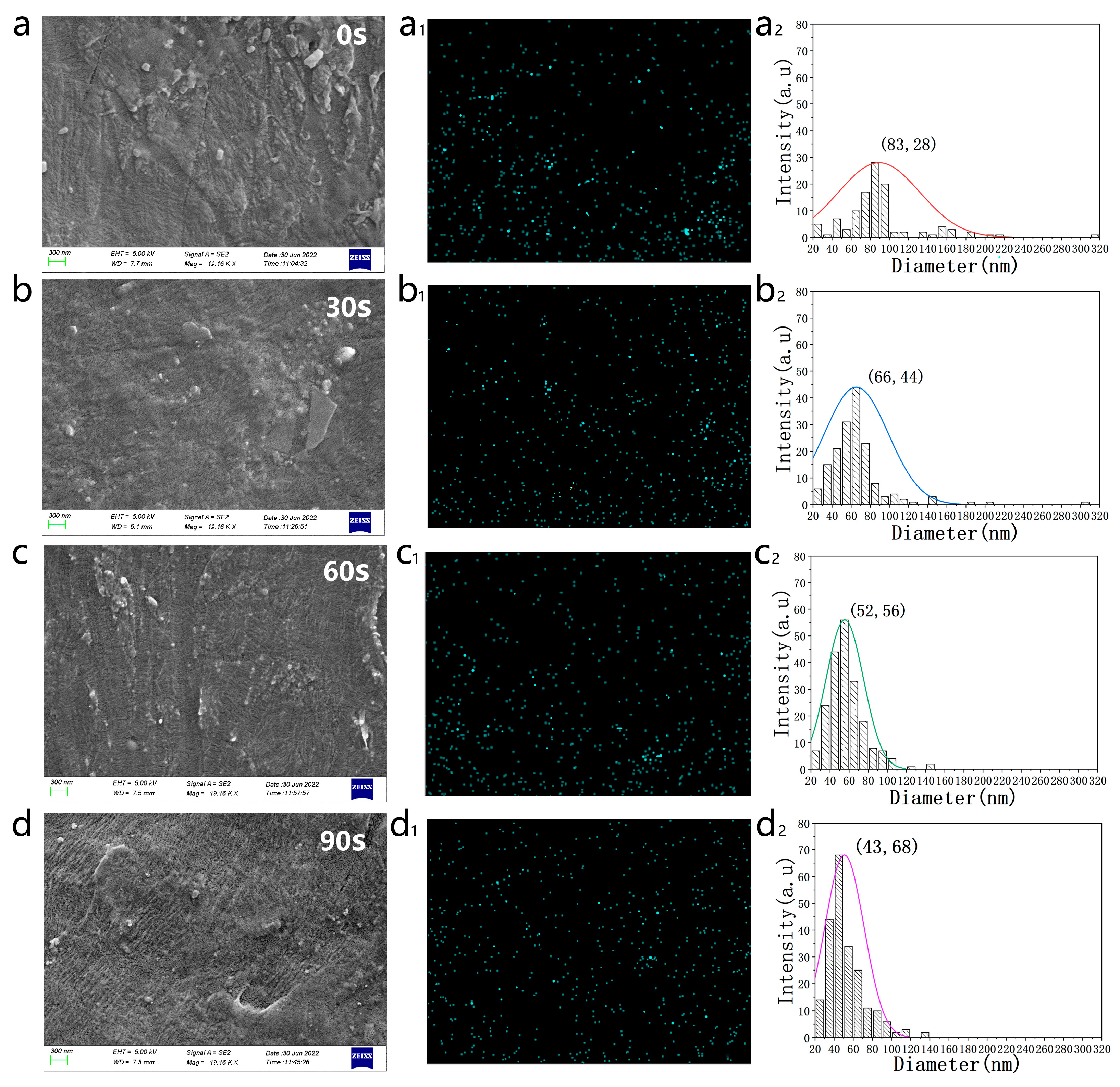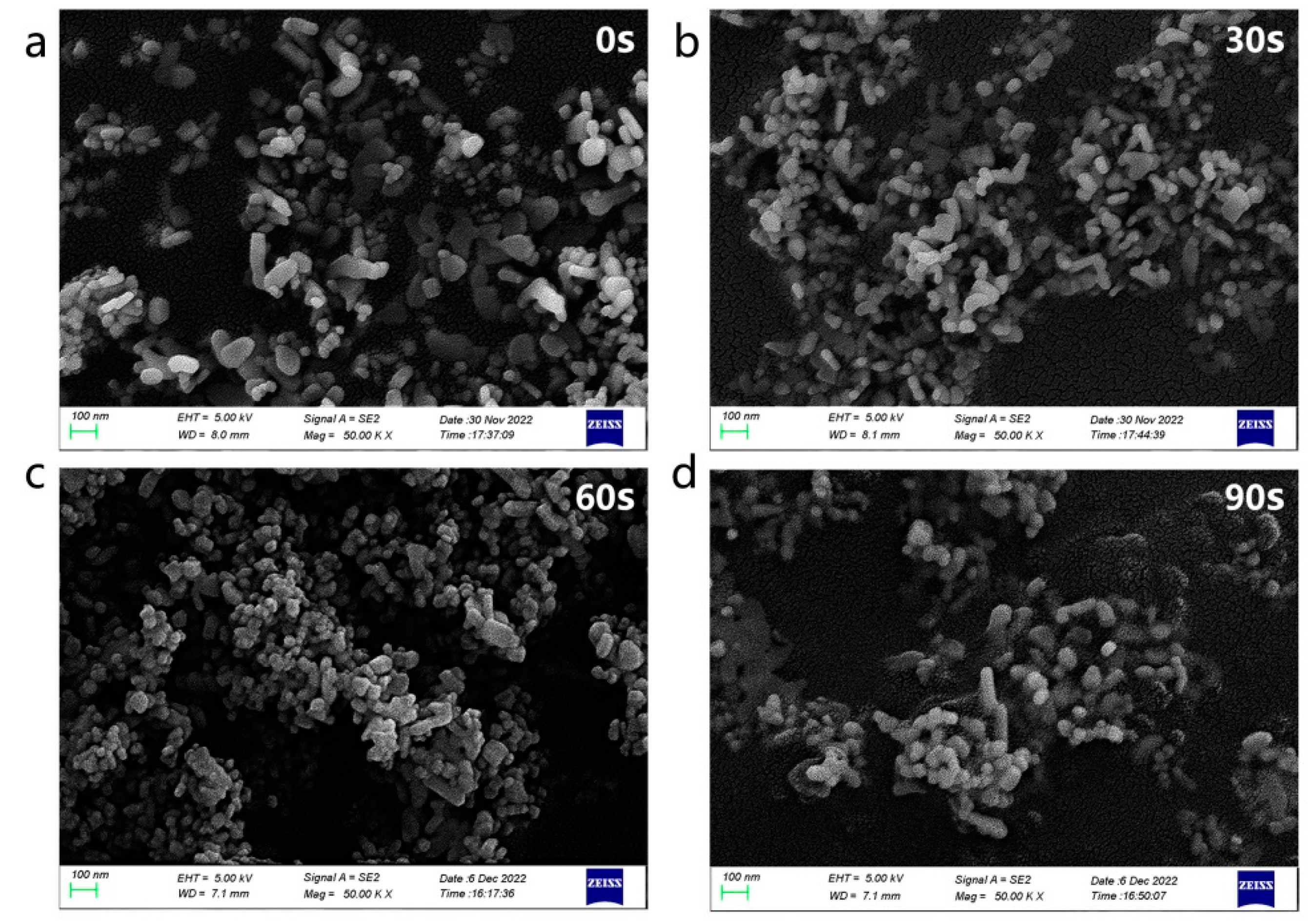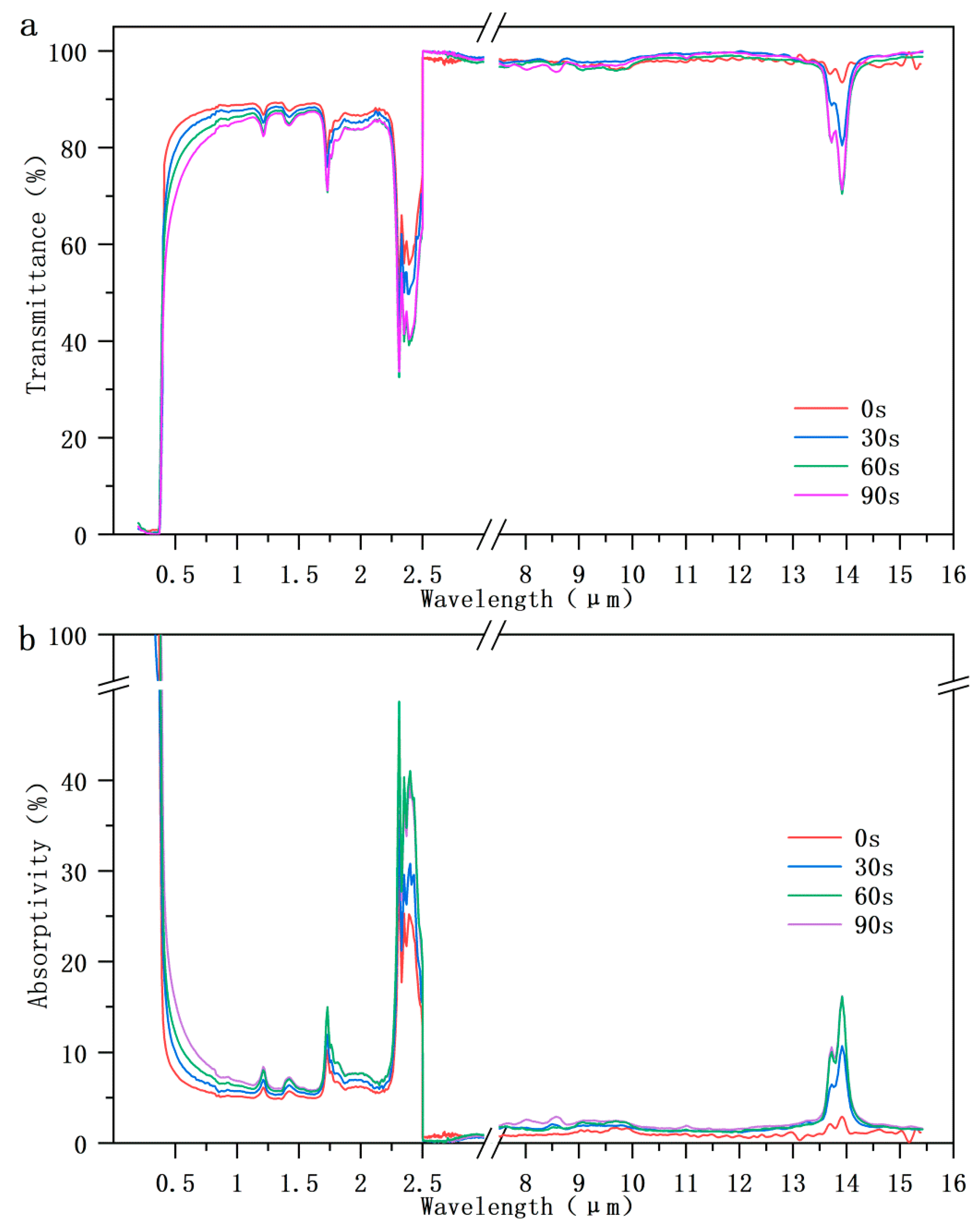Enhancement of Intrinsic Temperature Reduction for Plasma Surface-Modified Nanoparticle-Doped Low-Density Polyethylene Films
Abstract
:1. Introduction
2. Materials and Methods
2.1. Materials
2.2. Plasma Treatment
2.3. Preparation of ZnO-Doped LDPE Films
2.4. Scanning Electron Microscopy Analysis
2.5. Optical Performance Test
2.6. Differential Scanning Calorimetry Test
2.7. Radiative-Cooling Performance Test
2.8. Statistical Analysis
3. Results and Discussion
3.1. Morphology Analysis
3.2. Thermal Properties
3.3. Transmittance of ZnO/LDPE Films
3.4. Cooling Performances
4. Conclusions
Author Contributions
Funding
Institutional Review Board Statement
Informed Consent Statement
Data Availability Statement
Acknowledgments
Conflicts of Interest
References
- Cai, L.; Song, A.Y.; Li, W.; Hsu, P.-C.; Lin, D.; Catrysse, P.B.; Liu, Y.; Peng, Y.; Chen, J.; Wang, H.; et al. Spectrally Selective Nanocomposite Textile for Outdoor Personal Cooling. Adv. Mater. 2018, 30, 1802152. [Google Scholar] [CrossRef] [PubMed]
- Mandal, J.; Fu, Y.; Overvig, A.C.; Jia, M.; Sun, K.; Shi, N.N.; Zhou, H.; Xiao, X.; Yu, N.; Yang, Y. Hierarchically porous polymer coatings for highly efficient passive daytime radiative cooling. Science 2018, 362, 315–319. [Google Scholar] [CrossRef]
- Tong, J.K.; Huang, X.; Boriskina, S.V.; Loomis, J.; Xu, Y.; Chen, G. Infrared-transparent visible-opaque fabrics for wearable personal thermal management. Acs Photonics 2015, 2, 769–778. [Google Scholar] [CrossRef]
- Yang, A.; Cai, L.; Zhang, R.; Wang, J.; Hsu, P.-C.; Wang, H.; Zhou, G.; Xu, J.; Cui, Y. Thermal management in nanofiber-based face mask. Nano Lett. 2017, 17, 3506–3510. [Google Scholar] [CrossRef] [PubMed]
- Cui, L.; Ni, Q.-Q.; Liu, G.; Huang, C.; Zhang, C.; Song, J.; Luo, S.; Qiu, Y. Effect of Nanoparticle Concentration on Passive Cooling Performance of ZNO-Low Density Polyethylene Composite Films Under Solar Radiation. Sampe J. 2021, 57, 36–45. [Google Scholar]
- Li, W.; Fan, S. Nanophotonic control of thermal radiation for energy applications [Invited]. Opt. Express 2018, 26, 15995–16021. [Google Scholar] [CrossRef]
- Pereira, J.; Gloria Gomes, M.; Moret Rodrigues, A.; Almeida, M. Thermal, luminous and energy performance of solar control films in single-glazed windows: Use of energy performance criteria to support decision making. Energy Build. 2019, 198, 431–443. [Google Scholar] [CrossRef]
- Yin, X.; Yang, R.; Tan, G.; Fan, S. Terrestrial radiative cooling: Using the cold universe as a renewable and sustainable energy source. Science 2020, 370, 786. [Google Scholar] [CrossRef]
- Raman, A.P.; Abou Anoma, M.; Zhu, L.; Rephaeli, E.; Fan, S. Passive radiative cooling below ambient air temperature under direct sunlight. Nature 2014, 515, 540–544. [Google Scholar] [CrossRef]
- Huang, Z.; Ruan, X. Nanoparticle embedded double-layer coating for daytime radiative cooling. Int. J. Heat Mass Transf. 2017, 104, 890–896. [Google Scholar] [CrossRef]
- Zhai, Y.; Ma, Y.; David, S.N.; Zhao, D.; Lou, R.; Tan, G.; Yang, R.; Yin, X. Scalable-manufactured randomized glass-polymer hybrid metamaterial for daytime radiative cooling. Science 2017, 355, 1062–1066. [Google Scholar] [CrossRef] [PubMed]
- Aili, A.; Wei, Z.; Chen, Y.; Zhao, D.; Yang, R.; Yin, X. Selection of polymers with functional groups for daytime radiative cooling. Mater. Today Phys. 2019, 10, 100127. [Google Scholar] [CrossRef]
- Cui, L.; Huang, C.; Xia, H.; Qiu, Y.; Ni, Q.-Q. Transparent ultraviolet-shielding composite films made from dispersing pristine zinc oxide nanoparticles in low-density polyethylene. Nanotechnol. Rev. 2020, 9, 1368–1380. [Google Scholar] [CrossRef]
- Hsieh, A.-H.; Corti, D.S.; Franses, E.I. Rayleigh and Rayleigh-Debye-Gans light scattering intensities and spetroturbidimetry of dispersions of unilamellar vesicles and multilamellar liposomes. J. Colloid Interface Sci. 2020, 578, 471–483. [Google Scholar] [CrossRef]
- Wang, Y.; Gao, X.; Wu, X.; Zhang, W.; Luo, C.; Liu, P. Facile design of 3D hierarchical NiFe2O4/N-GN/ZnO composite as a high performance electromagnetic wave absorber. Chem. Eng. J. 2019, 375, 121942. [Google Scholar] [CrossRef]
- Ong, T.; Xu, L.; van der Laan, T.A.; Xu, S.; Ostrikov, K. Plasma-aided hydrogenation and Al-doping: Increasing the conductivity and optical transparency of ZnO transparent conducting oxide. Appl. Surf. Sci. 2011, 257, 9986–9990. [Google Scholar] [CrossRef]
- Chen, Z.; Wang, J.; Wu, H.; Yang, J.; Wang, Y.; Zhang, J.; Bao, Q.; Wang, M.; Ma, Z.; Tress, W.; et al. A Transparent Electrode Based on Solution-Processed ZnO for Organic Optoelectronic Devices. Nat. Commun. 2022, 13, 4387. [Google Scholar] [CrossRef]
- Taya, Y.A.; Abd El-Raheem, M.M.; Ali, H.M.; Mohamed, H.A.; Hakeem, A.M.A. Optical and electrical properties of GaZnO films deposited by co-sputtering method on two types of substrates. Phase Transit. 2022, 95, 581–595. [Google Scholar] [CrossRef]
- Mahmoudi Khatir, N.; Abdul-Malek, Z.; Zak, A.K.; Akbari, A.; Sabbagh, F. Sol–gel grown Fe-doped ZnO nanoparticles: Antibacterial and structural behaviors. J. Sol.-Gel Sci. Technol. 2015, 78, 91–98. [Google Scholar] [CrossRef]
- Khatir, N.M.; Sabbagh, F. Green Facile Synthesis of Silver-Doped Zinc Oxide Nanoparticles and Evaluation of Their Effect on Drug Release. Materials 2022, 15, 5536. [Google Scholar] [CrossRef]
- Chandran, S.; Begam, N.; Padmanabhan, V.; Basu, J.K. Confinement enhances dispersion in nanoparticle-polymer blend films. Nat. Commun. 2014, 5, 3697. [Google Scholar] [CrossRef] [PubMed]
- Yuan, W.; Zhou, Y. Reasons for Agglomeration of Nanoparticle and Solutions. Mater. Rep. 2008, 22, 59–61. [Google Scholar]
- LaNasa, J.A.; Neuman, A.; Riggleman, R.A.; Hickey, R.J. Investigating Nanoparticle Organization in Polymer Matrices during Reaction-Induced Phase Transitions and Material Processing. Acs Appl. Mater. Interfaces 2021, 13, 42104–42113. [Google Scholar] [CrossRef] [PubMed]
- Kumar, S.K.; Benicewicz, B.C.; Vaia, R.A.; Winey, K.I. 50th Anniversary Perspective: Are Polymer Nanocomposites Practical for Applications? Macromolecules 2017, 50, 714–731. [Google Scholar] [CrossRef]
- Diao, H.; Si, Y.; Zhu, A.; Ji, L.; Shi, H. Surface modified nano-hydroxyapatite/poly(lactide acid) composite and its osteocyte compatibility. Mater. Sci. Eng. C 2012, 32, 1796–1801. [Google Scholar]
- Shojaeiarani, J.; Bajwa, D.; Holt, G. Sonication amplitude and processing time influence the cellulose nanocrystals morphology and dispersion. Nanocomposites 2020, 6, 41–46. [Google Scholar] [CrossRef]
- Avolio, R.; Gentile, G.; Cocca, M.; Avella, M.; Errico, M.E. Role of silica nanoparticles on network formation and properties in thermoset polycarbonate based nanocomposites. Polym. Test. 2017, 60, 388–395. [Google Scholar] [CrossRef]
- Machrafi, H. On the chemical potential of nanoparticle dispersion. Phys. Lett. A 2020, 384, 126485. [Google Scholar] [CrossRef]
- Mitra, A.; Trifkovic, M.; Ponnurangam, S. Surface Functionalization-Induced Effects on Nanoparticle Dispersion and Associated Changes in the Thermophysical Properties of Polymer Nanocomposites. Macromolecules 2021, 54, 3962–3971. [Google Scholar] [CrossRef]
- Zhang, W.; Lai, E.P.C. Chemical Functionalities of 3-aminopropyltriethoxy-silane for Surface Modification of Metal Oxide Nanoparticles. Silicon 2022, 14, 6535–6545. [Google Scholar] [CrossRef]
- Wang, Y.; Jiang, S. Research progress on surface grafting modification of inorganic nanoparticles based on atom transfer radical polymerization. New Chem. Mater. 2019, 47, 42–45. [Google Scholar]
- Shen, Q.; Xing, D.Y.; Sun, F.; Dong, W.; Zhang, F. Designed water channels and sieving effect for heavy metal removal by a novel silica-poly(ionic liquid) nanoparticles TFN membrane. J. Membr. Sci. 2022, 641, 119945. [Google Scholar] [CrossRef]
- Zendejo-Covarrubias, R.; Idalia Narro-Cespedes, R.; Neira-Velazquez, G.; Cruz-Delgado, V.J.; Ku-Herrera, J.J.; Borjas-Ramos, J.; Arias-Garcia, G.; Soria-Arguello, G. Surface Modification of Graphene Nanoparticles With Ethylene Plasma in Rotary Plasma Reactor for the Preparation of GnP/HDPE Nanocomposites. IEEE Trans. Plasma Sci. 2018, 46, 2402–2406. [Google Scholar] [CrossRef]
- Miller, K.K.; Gottfried, J.L.; Walck, S.D.; Pantoya, M.L.; Wu, C.-C. Plasma surface treatment of aluminum nanoparticles for energetic material applications. Combust. Flame 2019, 206, 211–213. [Google Scholar] [CrossRef]
- Liu, Y.; Sun, D.; Askari, S.; Patel, J.; Macias-Montero, M.; Mitra, S.; Zhang, R.; Lin, W.F.; Mariotti, D.; Maguire, P. Enhanced Dispersion of TiO2 Nanoparticles in a TiO2/PEDOT:PSS Hybrid Nanocomposite via Plasma-Liquid Interactions. Sci. Rep. 2015, 5, 15765. [Google Scholar] [CrossRef]
- Borjas-Ramos, J.J.; Ramos-de-Valle, L.F.; Neira-Velazquez, M.G.; Hernandez-Hernandez, E.; Saucedo-Salazar, E.M.; Soria-Arguello, G. Thermal Conductivity of Nanocomposites Based in High Density Polyethylene and Surface Modified Hexagonal Boron Nitride via Cold Ethylene Plasma. Plasma Chem. Plasma Process. 2018, 38, 429–441. [Google Scholar] [CrossRef]
- Saman, N.M.; Zakaria, I.H.; Ahmad, M.H.; Abdul-Malek, Z. Effects of Plasma Treated Alumina Nanoparticles on Breakdown Strength, Partial Discharge Resistance, and Thermophysical Properties of Mineral Oil-Based Nanofluids. Materials 2021, 14, 3610. [Google Scholar] [CrossRef]
- Cui, L.; Huang, C.; Xia, H.; Qiu, Y.; Ni, Q.-Q. Transparent passive-cooling composite films for indoor and outdoor spaces. Compos. Commun. 2021, 24, 100611. [Google Scholar] [CrossRef]
- Jiang, Q.R.; Li, R.X.; Sun, J.; Wang, C.X.; Peng, S.J.; Ji, F.; Yao, L.; Qiu, Y.P. Influence of ethanol pretreatment on effectiveness of atmospheric pressure plasma treatment of polyethylene fibers. Surf. Coat. Technol. 2009, 203, 1604–1608. [Google Scholar] [CrossRef]
- Zou, J.; Zhang, Y.C.; Huang, J.; Wu, H.Y.; Qiu, Y. Preparation and Properties of PP/PLA/Multiwall Carbon Nanotube Composites Filaments Obtained by Melt Compounding; Materials Science Forum; Trans Tech Publications: Stafa-Zurich, Switzerland, 2009; pp. 465–468. [Google Scholar]









| Area | 0 s | 30 s | 60 s | 90 s |
|---|---|---|---|---|
| Transmissivity curve (s−1) | 178.1 | 173.5 | 168.4 | 165.9 |
| Absorptivity curve (s−1) | 0.16 | 0.19 | 0.22 | 0.23 |
| Specimen | 0 s (°C) | 30 s (°C) | 60 s (°C) | 90 s (°C) |
|---|---|---|---|---|
| 1 | 7.69 | 8.5 | 10.27 | 11.28 |
| 2 | 6.18 | 7.04 | 8.58 | 9.53 |
| 3 | 6.6 | 8.17 | 9.17 | 10.22 |
| Mean ± SD | 6.82 ± 0.64 | 7.90 ± 0.63 | 9.34 ± 0.7 | 10.34 ± 0.72 |
| ΔT0 | 7.27 | 8.54 | 10.23 | 11.40 |
| Max Improvement (%) | - | 17.4 | 40.6 | 56.8 |
Disclaimer/Publisher’s Note: The statements, opinions and data contained in all publications are solely those of the individual author(s) and contributor(s) and not of MDPI and/or the editor(s). MDPI and/or the editor(s) disclaim responsibility for any injury to people or property resulting from any ideas, methods, instructions or products referred to in the content. |
© 2023 by the authors. Licensee MDPI, Basel, Switzerland. This article is an open access article distributed under the terms and conditions of the Creative Commons Attribution (CC BY) license (https://creativecommons.org/licenses/by/4.0/).
Share and Cite
Qiu, C.; Qiu, Y.; Zhang, Y.; Cui, L. Enhancement of Intrinsic Temperature Reduction for Plasma Surface-Modified Nanoparticle-Doped Low-Density Polyethylene Films. Crystals 2023, 13, 707. https://doi.org/10.3390/cryst13040707
Qiu C, Qiu Y, Zhang Y, Cui L. Enhancement of Intrinsic Temperature Reduction for Plasma Surface-Modified Nanoparticle-Doped Low-Density Polyethylene Films. Crystals. 2023; 13(4):707. https://doi.org/10.3390/cryst13040707
Chicago/Turabian StyleQiu, Chenlei, Yiping Qiu, Yinjia Zhang, and Lina Cui. 2023. "Enhancement of Intrinsic Temperature Reduction for Plasma Surface-Modified Nanoparticle-Doped Low-Density Polyethylene Films" Crystals 13, no. 4: 707. https://doi.org/10.3390/cryst13040707
APA StyleQiu, C., Qiu, Y., Zhang, Y., & Cui, L. (2023). Enhancement of Intrinsic Temperature Reduction for Plasma Surface-Modified Nanoparticle-Doped Low-Density Polyethylene Films. Crystals, 13(4), 707. https://doi.org/10.3390/cryst13040707





